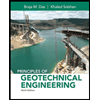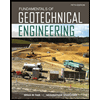![MindTap Engineering for Das/Sobhan's Principles of Geotechnical Engineering, SI Edition, 9th Edition, [Instant Access], 2 terms (12 months)](https://s3.amazonaws.com/compass-isbn-assets/textbook_empty_images/large_textbook_empty.svg)
(a)
Find the change in effective stress
(a)
Answer to Problem 9.4P
The change in effective stress at point C when the water table drops by 2 m is
Explanation of Solution
Given information:
The thickness
The thickness
The thickness
The void ratio (e) of soil in the first layer is 0.7.
The specific gravity
The void ratio (e) of soil in the second layer is 0.55.
The depth (h) of water table drop is 2 m.
Calculation:
Determine the dry unit weight
Here,
Take the unit weight of the water as
Substitute 2.69 for
Determine the dry unit weight
Substitute 2.7 for
Determine the saturated unit weight
Substitute
Calculate the total stress at point C (13 m) using the relation.
Substitute
Calculate the pore water pressure at point C (13 m) using the relation.
Substitute
Calculate the effective stress at point C (13 m) using the relation.
Substitute
Water table drops by 2 m:
Calculate the total stress at point C when the water level drops by 2 m using the relation.
Substitute
Calculate the pore water pressure at point C when the water table drops by 2 m using the relation.
Substitute
Calculate the effective stress at point C when the water table drops by 2 m using the relation.
Substitute
Determine the change in effective stress when the water level drops by 2 m from the original position using the relation;
Substitute
Thus, the change in effective stress at point C when the water table drops by 2 m is
(b)
The change in effective stress
(b)
Answer to Problem 9.4P
The change in effective stress at point C rises to the surface up to point A is
Explanation of Solution
Given information:
The thickness
The thickness
The thickness
The void ratio (e) of soil in the first layer is 0.7.
The specific gravity
The void ratio (e) of soil in the second layer is 0.55.
Calculation:
Determine the saturated unit weight
Substitute
Calculate the total stress at point C (13 m) using the relation.
Substitute
Calculate the pore water pressure at point C (13 m) using the relation.
Substitute
Calculate the effective stress at point C (13 m) using the relation.
Substitute
Water table rises to the surface up to point A:
Determine the change in effective stress when the water table rises to the surface up to point A using the relation;
Substitute
Thus, the change in effective stress at point C rises to the surface up to point A is
(c)
Find the change in effective stress
(c)
Answer to Problem 9.4P
The change in effective stress at point C when the water level rises 3 m above point A due to flooding is
Explanation of Solution
Given information:
The thickness
The thickness
The thickness
The void ratio (e) of soil in the first layer is 0.7.
The specific gravity
The depth (h) of water rises above point A is 3.0 m.
Calculation:
Calculate the total stress at point C (16 m) using the relation.
Substitute
Calculate the pore water pressure at point C (16 m) using the relation.
Substitute
Calculate the effective stress at point C (16 m) using the relation.
Substitute
Water level rises 3 m above point A due to flooding:
Determine the change in effective stress when the water level rises 3 m above point A due to flooding using the relation;
Substitute
Thus, the change in effective stress at point C when the water level rises 3 m above point A due to flooding is
Want to see more full solutions like this?
Chapter 9 Solutions
MindTap Engineering for Das/Sobhan's Principles of Geotechnical Engineering, SI Edition, 9th Edition, [Instant Access], 2 terms (12 months)
- please helparrow_forwardAS Q1/ The specific gravity of the soil is 1.41 percentage of water content by weight at field capacity and wilting point are 15% and 7% respectively calculate the equivalent moisture content as equivalent depth for 1.2m root zone : 1. at permanent wilting point 2. at field capacity 3. for ready available waterarrow_forwardQuestion 6 The following figure shows peak-hour volumes for an intersection. Using Webster's method, determine a suitable signal timing for the intersection using the four-phase system shown below. Use an amber interval of 3 seconds and the saturation flow given in the table. O 100 O Phase Lime Group Saturation Flow A e 1615-> 370 3700 B 1615 1615 3700 1615 3700arrow_forward
- PHF-0.91 Pedestrian volume is negligible. Question 7 A parking area with 60 bays has an initial count of 35 vehicles. The in-out survey data for 10-minute intervals is as per the table below. Complete the table, calculate the accumulation, occupancy (%), and parking load (veh.hrs) for each interval. Time (min) In Out Accumulation Occupancy Parking load (%) 0 3 10 2 4 20 1 1 30 1 3 40 1 6 50 1 4 60arrow_forwardQ3/ The following data represent the water depth in the soil of equal areas for specified field. Calculate the uniformity coefficient, efficiency and adequacy of irrigation. Net needed irrigation depth =75 mm (78-04, 79, 88, 85.21, 76,82)arrow_forwardA (A) Q1/ It is required to apply a net depth of 120mm to a total area of 60 ha. The applied discharge is continuously 180 L/s. What must be the time of irrigation? Assume the application efficiency 85%. а Eas 85 0% tarrow_forward
- The following figure is a flexible pavement system with the resilient moduli layer coefficients and drainage coefficients as shown. If the predicted ESAL = 6x106, Reliability, R = 99%, Standard Deviation (So) = 0.45, and APSI = 2.5, select thicknesses D1, D2, and D3 in accordance with the AASHTO Guide for Design of Pavement Structures. E₁ = 400, 000 psi; a₁ = 0.42, Thickness = D₁ E₂=30,000 psi; a₂= 0.14, m₂ = 1.2; Thickness = Dz E=11,000 psi; a=0.08, m3 = 1.2; Thickness = D3 MR= 5,700 psiarrow_forwardDiagramtically show the placement, size, and spacing of temperature steels, dowel bars and tie bars in rigid pavements. Also mention their puproses in rigid pavements.arrow_forwardA six-lane concrete roadway is being designed for a metropolitan area. This roadway will be constructed on a subgrade with an effective modulus of subgrade reaction k of 200 lb/in^3. The ESALs used for the design period is 6.0×10^6. Using the AASHTO design method, determine a suitable thickness of the concrete pavement (to the nearest 1/2 inch), provided that the working stress of the concrete to be used is 600 lb/in^2 and the modulus of elasticity is 6×10^6 lb/in^2. Assume the initial serviceability is 5.0 and the terminal serviceability is 2.0. Assume the overall standard deviation, So, is 0.35, the load transfer coefficient J as 3.2, the drainage coefficient, Cd, is 1.15, and R = 99%.arrow_forward
- A 12-in. full-depth asphalt pavement is placed on a subgrade with aneffective roadbed resilient modulus of 7,000 psi. Assuming a layer coefficient of 0.44 for the hot mix asphalt, a drop in PSI from 4.5 to 2.5, an overall standard deviation of 0.49, and a predicted ESAL of 10 X 10^6, determine the reliability of thedesign by using the AASHTO equation and check the result by using the AASHTO design chartarrow_forwardGiven the monthly resilient modulus below, find out relative damage of each month, the average relative damage and the effective roadbed resilient modulus.Month Resilient Modulus (psi):Jan 20,000Feb 22,000March 5,000April 6,000May 7,000June 8,000July 8,500August 9,500September 9,000October 8,000November 7,000December 18,000arrow_forwardDetermine the largest torque T that can be applied to each of the twoaluminium bars shown in Figure 5 below, and the corresponding angle of twistat B, knowing that allow = 50 MPa and G = 26 GPa. [10]Figure 5 : Aluminium Bars(Source: Mechanics of Materials Beer, Johnston, DeWolf & Mazurek 6Ed p204)arrow_forward
 Principles of Foundation Engineering (MindTap Cou...Civil EngineeringISBN:9781305081550Author:Braja M. DasPublisher:Cengage Learning
Principles of Foundation Engineering (MindTap Cou...Civil EngineeringISBN:9781305081550Author:Braja M. DasPublisher:Cengage Learning Principles of Geotechnical Engineering (MindTap C...Civil EngineeringISBN:9781305970939Author:Braja M. Das, Khaled SobhanPublisher:Cengage Learning
Principles of Geotechnical Engineering (MindTap C...Civil EngineeringISBN:9781305970939Author:Braja M. Das, Khaled SobhanPublisher:Cengage Learning Principles of Foundation Engineering (MindTap Cou...Civil EngineeringISBN:9781337705028Author:Braja M. Das, Nagaratnam SivakuganPublisher:Cengage Learning
Principles of Foundation Engineering (MindTap Cou...Civil EngineeringISBN:9781337705028Author:Braja M. Das, Nagaratnam SivakuganPublisher:Cengage Learning Fundamentals of Geotechnical Engineering (MindTap...Civil EngineeringISBN:9781305635180Author:Braja M. Das, Nagaratnam SivakuganPublisher:Cengage Learning
Fundamentals of Geotechnical Engineering (MindTap...Civil EngineeringISBN:9781305635180Author:Braja M. Das, Nagaratnam SivakuganPublisher:Cengage Learning



